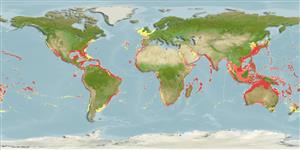Elasmobranchi (squali e razze) (sharks and rays) >
Carcharhiniformes (Ground sharks) >
Galeocerdonidae (Tiger sharks)
Etymology: Galeocerdo: galeos, a small shark or dogfish according to Aristotle and others (but perhaps used here as a generic term for shark); kerdo, Greek for fox, allusion not explained, perhaps referring to a cunning ability to steal bait from the line (see Alopias, Alopiidae). (See ETYFish); cuvier: Patronym not identified but almost certainly in honor of French naturalist Georges Cuvier (1769-1832), then most famous for his Le Règne Animal (1816), a survey of the animal kingdom based on comparative anatomy [presumably a noun in apposition, without the patronymic “i”]. (See ETYFish).
More on authors: Péron & Lesueur.
Environment: milieu / climate zone / depth range / distribution range
Ecologia
marino; salmastro benthopelagico; oceanodromo (Ref. 51243); distribuzione batimetrica 0 - 800 m (Ref. 96339), usually 0 - 140 m (Ref. 26938). Subtropical; 62°N - 44°S, 180°W - 180°E
Circumglobal in tropical and temperate seas. Western Atlantic: Massachusetts, USA to Uruguay, including Gulf of Mexico and the Caribbean. Eastern Atlantic: Iceland to Angola. Indo-Pacific: Persian Gulf (Ref. 68964), Red Sea and East Africa to Hawaii and Tahiti, north to southern Japan, south to New Zealand. Eastern Pacific: southern California, USA to Peru, including the Revillagigedo, Cocos, and Galapagos islands. Highly migratory species.
Length at first maturity / Size / Peso / Age
Maturity: Lm 300.0, range 210 - 350 cm
Max length : 750 cm TL maschio/sesso non determinato; (Ref. 58784); common length : 500 cm TL maschio/sesso non determinato; (Ref. 2683); peso massimo pubblicato: 807.4 kg (Ref. 4699); Età massima riportata: 50 anni (Ref. 4827)
Spine dorsali (totale): 0; Raggi dorsali molli (totale): 0; Spine anali 0; Raggi anali molli: 0. This species is a huge, vertical tiger-striped shark with a very short or broad, bluntly rounded snout (its length much less than width of mouth), long upper labial furrows (about as long as snout, reaching front of eyes), a big mouth with large, saw-edged, cockscomb-shaped teeth (coarsely serrated with outer edges deeply notched and tips directed obliquely outward); spiracles small, slit-like, but easily visible, caudal keels low. Colour of back dark grey or greyish brown with vertical dark grey to black bars and rectangular spots often forming bars on sides and fins, but fading with growth (Ref. 5578, 9997).
Usually found near surface to depths of 140 m (Ref. 26938); in Tahiti from 0-350 m (Ref. 89972). Occurs on or adjacent to continental and insular shelves, frequenting river estuaries, off wharves and jetties in harbors, and in coral atolls and lagoons (Ref. 244). Bottom-associated, sometimes pelagic (Ref. 58302). Also off oceanic islands far from other islands and continental land masses (Ref. 244). Makes excursions in the open ocean, but is not a truly oceanic species (Ref. 244). Nocturnal feeder on other sharks, rays, bony fishes, marine mammals, tortoises, seabirds, sea snakes, squids, gastropods, crustaceans, detritus (Ref. 9997), also including toxic or armored fish species such as Lactoria cornuta or Diodon hystrix, porpoises, whales, sea turtles, cephalopods, domestic animals and humans (Ref. 37816). It also feeds on carrion and garbage, including cans, pieces of metal and burlap bags (Ref. 26938). Second only to Carcharodon carcharias in recorded attacks on humans with at least 27 documented attacks sourced to it . One specimen, reportedly taken off Indo-China, weighed 3,110 kg and measured 740 cm (Ref. 9987). May be kept in an aquaria, but does not last for more than a few months (Ref. 244). Ovoviviparous (Ref. 50449). Up to 80 young of 51 to 104 cm are born per litter (Ref. 1602). Valued for its meat, fins, hide and liver oil (Ref. 9997) and also for its jaws and cartilage (Ref. 58048). Often used for fishmeal (Ref. 9997). Utilized fresh, dried-salted, smoked and frozen (Ref. 9987). Species from the Persian Gulf and Oman Sea has a max size of 750 cm TL (Ref. 47613).
Ovoviviparous (Ref. 4805, 6871) with 10-82 in a litter (Ref. 26346). Mating takes place even before gravid females have given birth (Ref. 244). Distinct pairing with embrace (Ref. 205). Gestation period: 13-16 months. Size at birth between 51 (Ref. 244) and 104 (Ref. 9997) cm TL; born at about 51-76 cm TL (Ref. 58048).
Compagno, L.J.V., 1984. FAO Species Catalogue. Vol. 4. Sharks of the world. An annotated and illustrated catalogue of shark species known to date. Part 2 - Carcharhiniformes. FAO Fish. Synop. 125(4/2):251-655. Rome: FAO. (Ref. 244)
IUCN Red List Status (Ref. 130435)
Human uses
Pesca: commerciale; Pesce da pesca sportiva: si
Strumenti
Special reports
Download XML
Fonti Internet
Estimates based on models
Preferred temperature (Ref.
123201): 15.8 - 28.9, mean 26.4 °C (based on 6872 cells).
Phylogenetic diversity index (Ref.
82804): PD
50 = 1.0000 [Uniqueness, from 0.5 = low to 2.0 = high].
Bayesian length-weight: a=0.00724 (0.00283 - 0.01852), b=3.09 (2.87 - 3.31), in cm total length, based on LWR estimates for this (Sub)family-body shape (Ref.
93245).
Trophic level (Ref.
69278): 4.5 ±0.0 se; based on diet studies.
Generation time: 10.3 ( na - na) years. Estimated as median ln(3)/K based on 2
growth studies.
Resilienza (Ref.
120179): Basso, tempo minimo di raddoppiamento della popolazione 4.5 - 14 anni (tm=4-11; tmax=50; K=0.18-0.6; Fec=10).
Prior r = 0.27, 95% CL = 0.12 - 0.63, Based on 1 stock assessment.
Fishing Vulnerability (Ref.
59153): High vulnerability (64 of 100).
Climate Vulnerability (Ref.
125649): High vulnerability (57 of 100).
Nutrients (Ref.
124155): Calcium = 4.57 [0.66, 26.59] mg/100g; Iron = 0.455 [0.113, 1.474] mg/100g; Protein = 21.6 [19.3, 23.7] %; Omega3 = 0.287 [0.118, 0.709] g/100g; Selenium = 52.8 [14.6, 163.1] μg/100g; VitaminA = 4.47 [1.34, 14.90] μg/100g; Zinc = 0.278 [0.132, 0.539] mg/100g (wet weight);
